Introduction
LED (Light Emitting Diode, LED) - a semiconductor diode that can emit light when a voltage is applied to it in the forward direction. In fact, this diode that converts electrical energy into light. Depending on the material from which the LED is manufactured, it can emit light of different wavelengths (different colors), and have different electrical characteristics. LEDs used in many areas of life as a means of displaying visual information. For example, a single emitter or in the form of several LED structures - segment display , LED matrices clusters and so forth. Also in recent years actively occupy segment LED lighting. They are used in automotive headlamps, flashlights, lamps and chandeliers.
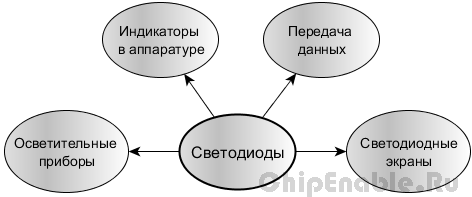
LED designation Scheme
Electrical schematic LED diode is denoted with two arrows. Arrows point from the diode, symbolizing the light emission. Do not confuse with a photodiode , whose arrows point to it. On domestic schemes lettering single LED - HL.

Conclusions and labeling LED
Standard monochrome LED has two terminals - is the anode and the cathode. Determine which of the conclusions is the anode can be visually observed. Do Leaded LEDs anode cathode usually longer.
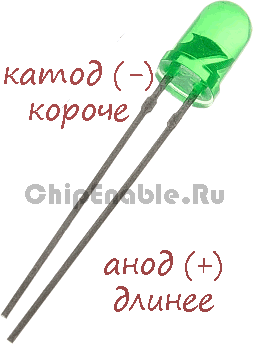
SMD LEDs have the same conclusions, but on the flipside there are usually marked with a triangle or similarity letter T. The anode is the conclusion to which faces one side of the triangle or the upper part of the letter T.
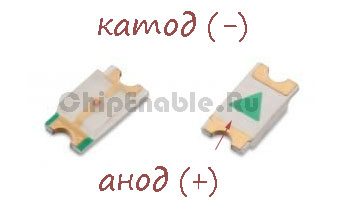
If you can not visually determine where what conclusions can ping LED. For this you will need a power supply or adapter, capable of producing a voltage of about 5 volts. Connect any output LED to negative source, and the second is connected to the positive terminal of the source through a resistance 200 - 300 ohms. If the LED is connected correctly, it glows. Otherwise, change the conclusions places and repeat the procedure.
resistor can be dispensed with, if not connect the positive terminal of power source and quickly "to strike" her conclusion on the LED. But generally apply a lot of stress on the LED, without limiting the current, you can not - it can fail!
Voltage LED
LED emits light when voltage is applied to it in the forward direction: towards the anode - plus, and the cathode - minus.

Minimum voltage at which the LED will glow depends on its material. The table below shows the values of the stress test LEDs at 20 mA and the colors they emit. This data was taken from the catalog company LEDs Vishay, different datasheets and Wikipedia.
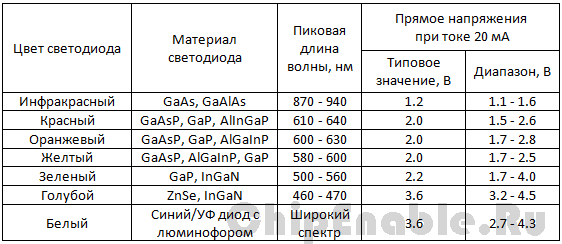
The biggest voltage is required for blue and white LEDs, and the smallest for the infrared and red.
radiation infrared LED is not visible to the human eye, so these LEDs are used as indicators. They are used in various sensors, lights cameras. By the way, if the infrared LED power-up and look at it through a mobile phone camera, it will be well visible glow.
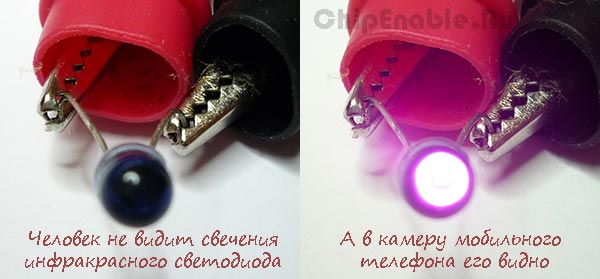
In the illustrated table shows the approximate voltage of the LED. This is usually enough to turn it on. The exact value of the specific LED forward voltage can be found in the datasheet it under Electrical Characteristics. There's a nominal value of forward voltage at a given current LED. For example, look at the datasheets on red SMD LED firm Kingbright.

Current-voltage characteristics of the LED
Current-voltage characteristics of the LED shows the relationship between the applied voltage and current of the LED. The figure below shows the direct branch of the same characteristics of the datasheet.
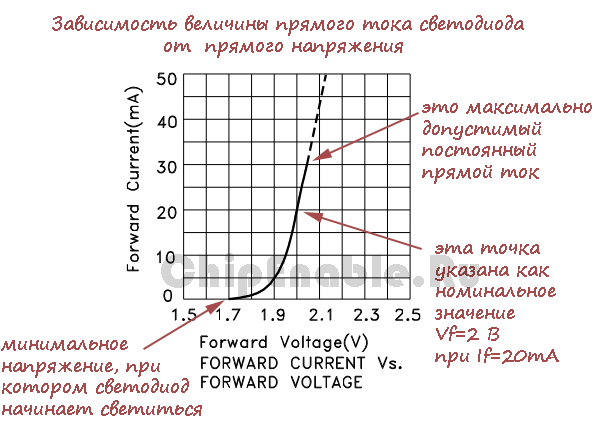
If the LED is connected to a power source (+ to the anode, the cathode -) and from zero to gradually increase the voltage on it, the LED current will vary according to this schedule. On it can be seen that after the point of "bend", the current through the LED will increase sharply at low voltage changes. This is precisely the reason why the LED can not be connected to any power source without a resistor, unlike incandescent bulbs.
The higher the current, the brighter the LED lights up. However, to increase the LED current to infinity, of course, impossible. High-current LED will overheat and burn. By the way, if you just apply a high voltage to the LED it can even slap as weak squib!
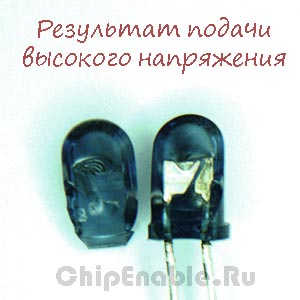
Other characteristics of LEDs
What other characteristics of the LEDs are of interest from the viewpoint of practical use?
Maximum power dissipation, the maximum values of continuous and pulsed direct current and maximum reverse voltage. These characteristics show the limit values of voltages and currents, which should not be exceeded. They are described in the datasheet under Absolute Maximum Ratings.
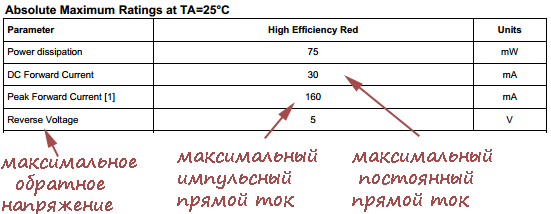
If the voltage applied to the LED in reverse direction, the LED lights up, and indeed may fail. The fact that the reverse voltage can occur breakdown , which resulted in the reverse LED current will increase dramatically. And if released on the LED power (reverse current * on reverse voltage) exceeds the permissible - it will burn. Some datasheets are supplemented with the reverse branch of the volt-ampere characteristics, which shows the voltage at which the breakdown occurs.
radiation intensity (light intensity)
Roughly speaking, it is the characteristic that determines the brightness of the LED for a given test current (typically 20 mA). Represented - Iv, as measured in mikrokandelah (mcd). The brighter the LED, the higher the value of Iv. The scientific definition of intensity is in the Wikipedia.
Also of interest is a graph of the relative intensity of the radiation from the LED forward current. Some LEDs, for example, by increasing the current intensity of the radiation increases less and less. The figure shows a few examples.
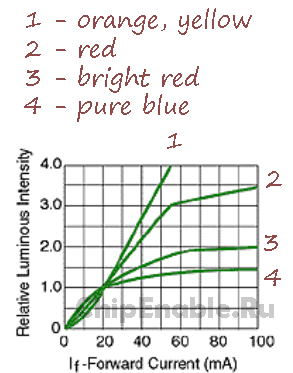
Spectral characteristic
It determines which wavelengths LED emits roughly emission color. Usually given peak wavelength value and graph of the emission intensity of the LED on the wavelength. I rarely look at the data. I know, for example, that the red LED and enough for me.

Climatic characteristics
They define the range of operating temperatures and the dependence of the parameters of the LED LED (direct current and emission intensity) versus temperature. If you plan to use the LED at high or low temperatures, you should pay attention to these characteristics.

How does the LED?
The material is designed for novice electronics, so I purposely did not touch the physics of the LED. The realization that the LED emits photons as a result of recombination of charge carriers in the pn junction, carries no useful information for practical use LEDs. And not only for use, but also for understanding in principle.
However, if you want to delve into this topic, I give direction where to dig - Pasynkov VV, Chirkin LK"Semiconductors" or Zi.S "Physics of Semiconductor Devices." This university `ovskie textbooks - there all grown-up.
